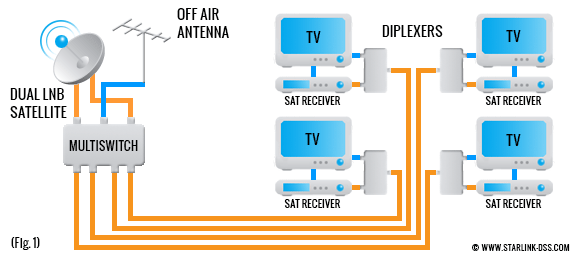You can use a multiswitch to split the signal from a single satellite dish to run multiple receivers. A basic [easyazon-link keywords=”multiswitch” locale=”us”]multiswitch[/easyazon-link] has 3 inputs and 4 or 8 outputs. This enables the signal from a dual output LNB dish to run up to 4 receivers with a 3×4 version, or up to 8 receivers on a 3×8 multi switch.
The center input is reserved for a feed from cable TV or an Off-Air Antenna (To receive local channels). The Satellite & Off-Air signals are separated out at the receiver end using a Diplexer (See Fig 1).
Multiswitch Signal Distribution
Both the [easyazon-link asin=”B0007WWI2O” locale=”us”]Eagle Aspen multiswitch[/easyazon-link] and [easyazon-link asin=”B000MLGNN0″ locale=”us”]Zinwell multiswitch[/easyazon-link] (see below) are DirecTV approved. They are excellent for expanding your DSS (Digital Satellite System) to run up to 4 receivers at once without the need for a multi-satellite setup. They are a robust design and can be used indoor or outdoors (although indoors is recommended). They also receive power through the satellite receiver so no external power supply is required.
[easyazon-image align=”left” asin=”B0007WWI2O” locale=”us” height=”143″ src=”https://starlink-dss.com/wp-content/uploads/2012/07/Eagle_Aspen_Multiswitch.png” alt=”Eagle Aspen Multiswitch” width=”261″ height=”243″][easyazon-image align=”right” asin=”B000MLGNN0″ locale=”us” height=”160″ src=”https://starlink-dss.com/wp-content/uploads/2012/07/Zinwell_Multiswitch.png” alt=”Zinwell Multiswitch” width=”261″ height=”243″]
Input & Output Connection via F Connector (Female) on standard RG6 coax cable
If you have long cable runs from the satellite dish to your multiswitch it is advisable to amplify the signal. This can be acheived using a slope compensated signal booster like the [easyazon-link keywords=”Eagle Aspen 2150 In-Line Amplifier” locale=”us”]Eagle Aspen 2150 In-Line Amplifier[/easyazon-link] (These devices are also powered via the receiver). You will need one per feed from the satellite i.e. 2 for a dual or 4 for a quad LNB.
Another application for a multiswitch is connecting an additional DVR ([easyazon-link keywords=”Digital Video Recorder” locale=”us”]Digital Video Recorder[/easyazon-link]) or [easyazon-link keywords=”TiVo” locale=”us”]TiVo[/easyazon-link] into your system. These devices have dual tuners and therefore need two feeds. A multiswitch is an ideal way to increase the number of feeds to run your extra DVR leaving other feeds for receivers in other rooms.
Single Wire Multiswitch – DirecTV SWM8
Another approach to signal distribution specifically for DirecTV is the [easyazon-link keywords=”single wire multiswitch” locale=”us”]single wire multiswitch[/easyazon-link] SWM (SWM8 or SWM16). The single wire multiswitch allows two signals to flow through one RG6 coax cable, very useful for installations with limited pre-installed cable runs and also cuts the cost of adding extra cables.
The main advantage with the SWM is that combined with some specially designed signal splitters they can run dual tuner DVR’s using only one cable feed.
The [easyazon-link asin=”B001FG73YO” locale=”us”]SWM8[/easyazon-link] and [easyazon-link asin=”B003Z8TEF6″ locale=”us”]SWM16[/easyazon-link] are designed to be used with AT9 or AU9 5LNB DirecTV satellite dishes. They are compatible with a range of receivers and DVR’s (There are ports on the device that support older receiver models but these do not support SWM technology).
[easyazon-image align=”left” asin=”B001FG73YO” locale=”us” src=”https://starlink-dss.com/wp-content/uploads/2012/07/swm8.png” alt=”directv swm8″ width=”232″ height=”216″][easyazon-image align=”right” asin=”B003C292AC” locale=”us” src=”https://starlink-dss.com/wp-content/uploads/2012/07/swm8_power_supply.png” alt=”swm8 power supply” width=”232″ height=”216″]
See product specifications for [easyazon-link asin=”B001FG73YO” locale=”us”]SWM8[/easyazon-link] and the required [easyazon-link asin=”B003C292AC” locale=”us”]Power Inserter[/easyazon-link] (Pictured Above)
Multiswitch – Installation Details
In a typical satellite television installation, one satellite dish is connected to one television through an interface box. This box is responsible for authenticating with the satellite network using an authorization card and encryption key. It also converts incoming radio signals from the satellite dish into a digital stream of MPEG4 frames.
In addition, it converts this information into analog or digital signals that can be interpreted by a television. Typically, the outputs are RF, composite, component, HDMI, DVI and/or VGA. Audio is output via RCA jacks, 3.5mm stereo jacks or the SP-DIF optical audio interface.
However, in many applications, more than one interface box and television must connect to the same dish. In this situation, the satellite dish needs to connect through a [easyazon-link keywords=”multiswitches” locale=”us”]multiswitch[/easyazon-link]. A multiswitch is bidirectional, meaning it is capable of sending and receiving data. It splits incoming signals to multiple interface boxes. In this manner, individual televisions are able to tune into different programs at the same time.
The number of televisions and interface boxes that can be connected and used at one time is determined by the available bandwidth on the satellite’s uplink and downlink. If the uplink is saturated, sending commands such as changing channels or ordering on-demand content will be slowed down. If the downlink is saturated, the video frame rate may decrease, resulting in a choppy image.
Audio quality can be affected. In addition, the image on the television may freeze, producing a “blocky” image. This is the digital equivalent to analog “static” or “snow”. These effects can be reduced by turning off some of the attached interface boxes or disconnecting them entirely from the multiswitch.
Multiswitches are also responsible for signal amplification. By lengthening the cable run between any given interface box and the satellite dish, more potential for signal loss and outside interference is introduced. Multiswitches that include an on-board repeater can help to alleviate this problem. However, for those that don’t include signal amplificatyion either an [easyazon-link keywords=”in-line amplifier” locale=”us”]in-line amplifier[/easyazon-link] or [easyazon-link keywords=”satellite signal booster” locale=”us”]satellite signal booster[/easyazon-link] should be investigated. These are able to amplify the signal without also amplifying any unwanted noise that may be present on the line.
Signal problems can be caused by poor termination. Any port on a multiswitch that is not connected to an interface box should be terminated. Otherwise, “signal bounce” can occur. This causes strange effects such as impedance mismatches, signal degradation, decreased transfer performance or a complete inability for the local network to function.
Multiswitches with less output ports are typically less expensive. To reduce installation costs, choose [easyazon-link keywords=”multiswitches” locale=”us”]multiswitches[/easyazon-link] with the exact number of ports that you anticipate using. You might consider choosing a model with one extra port so that you have room to expand the network later. However, be sure that this port is capped or terminated as specified by the manufacturer.

